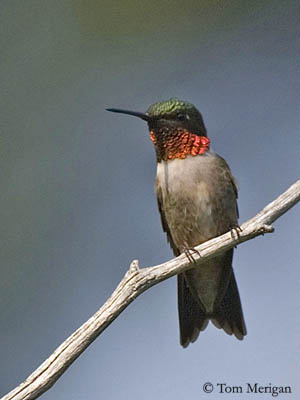
Ruby-throated Hummingbird
Archilochus colubris
Apodiforme Order – Trochilidae Family
BIOMETRICS:
Length: 7-9 cm
Wingspan: 8-11 cm
Weight: m: 3, 4 g – F: 3, 8 g
LONGEVITY: Up to 9 years
Fr: Colibri à gorge rubis
All : Rubinkehlkolibri
Esp : Colibrí Gorgirrubí
Ital : Colibri Golarubino
Nd : Robijnkeeltje
Sd : Rubinkolibri
Photographs by Bob Moul
His website :
Nature Photography
Photographs of adult male by Tom Merigan
His website :
Tom Meriganís Photo Galleries
Text by Nicole Bouglouan
Sources:
HANDBOOK OF THE BIRDS OF THE WORLD Vol 5 by Josep del Hoyo-Andrew Elliott-Jordi Sargatal - Lynx Edicions - ISBN: 8487334253
FIELD GUIDE TO THE BIRDS OF NORTH AMERICA - National Geographic Society - ISBN: 0792274512
A GUIDE TO THE BIRDS OF MEXICO AND NORTHERN CENTRAL AMERICA by Steve N. G. Howell, Sophie Webb - Oxford University Press - ISBN: 0198540124
Wikipedia (Wikipedia, The Free Encyclopedia)
All About Birds (Cornell Lab of Ornithology)
Animal Diversity Web (University of Michigan Museum of Zoology)
What Bird-The ultimate Bird Guide (Mitchell Waite)

DESCRIPTION:
Ruby-throated Hummingbird male has metallic bronze green back and head. Throat is iridescent ruby red. Chin, malar region, around eyes and auricular are black, and we can see a small white wash behind eyes.
Breast is whitish, becoming darker brownish-grey on low breast and belly. Sides and flanks are dusky green. Tail is forked, with dark purplish or black feathers. Undertail coverts are brownish grey, with dull white edges.
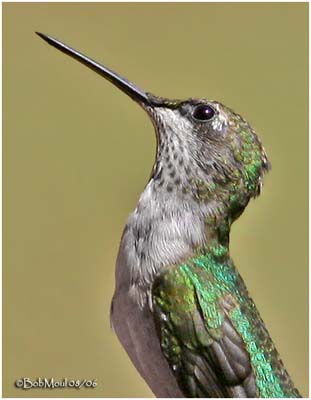
Ruby-Throated Hummingbird has a long needle-like bill.
Eyes are black.
Legs and feet are dark grey.
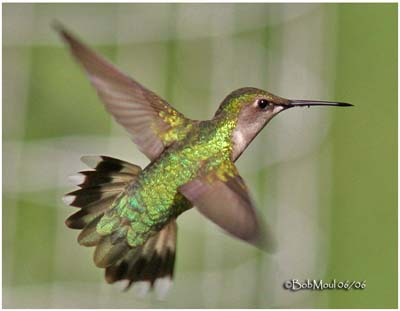
Female is larger than male. She has white throat, and white tips on tail feathers.
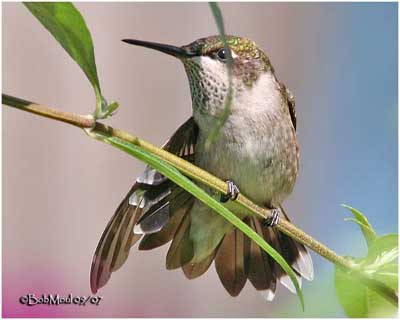
Juvenile is similar to adult female. Young male has dusky streaks on throat and few iridescent red feathers.
VOICE: SOUNDS BY XENO-CANTO
Ruby-throated Hummingbird utters rapid squeaky chips. These vocalizations are used to defend territory from intruders. Defending male utters a single note, repeated with increasing volume.
HABITAT:
Ruby-throated Hummingbird breeds in deciduous and pine woodlands, forest edges, orchards and gardens.
It winters in tropical deciduous forests, hedgerows, and along rivers and marshes.
RANGE:
Ruby-throated Hummingbird breeds in the East of United States, and in southern Canada.
It winters in southern Mexico, Central America and West Indies.
BEHAVIOUR:
To feed, Ruby-throated Hummingbird takes advantage of “sapsucker wells” which attract small insects. It laps up the sap, and catches flies and gnats that congregate there. They also eat nectar flower, and they are attracted to red flowers, contrasting conspicuously against the green foliage. Ruby-throated Hummingbirds eat nectar from a variety of flowers. They may consume twice their body weight each day.
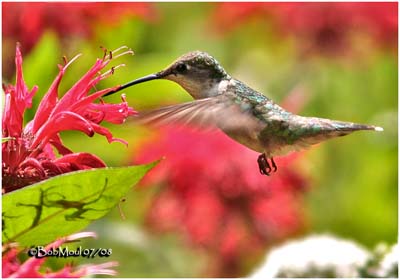
To eat nectar, it hovers above the plant and uses its long bill to suck out the nectar. It may catch insects in flight, or pluck them from leaves, and catch spiders from their webs. They are diurnal birds.
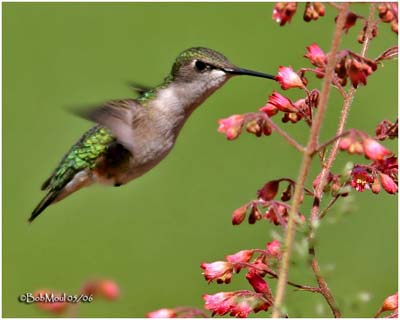
Ruby-throated Hummingbirds are solitary birds. Adults contact occurs only for mating. Male is territorial and chases the intruders, jabbing them with the bill or striking them with its feet.
If weather is cold, during the night, Ruby-throated Hummingbirds may save energy, entering in hypothermic torpor, a state similar to hibernation to conserve energy. To migrate, they double their body mass before departure.
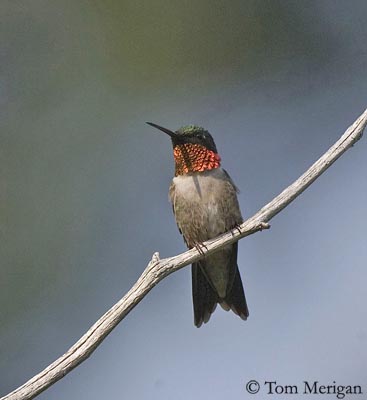
When courtship displays are engaged, male begins by erecting its red throat feathers, and harassing the female. Then, male performs a back-and-forth display flight, and side to side horizontal arcs, over the female.
These courtship flights are very spectacular, male flying upward 15 metres or more, and diving down at top of speed, pulling up at the last moment to complete a U-shaped pattern. This type of flight is repeated several times. Male utters vocal chattering while is flying. Sometimes, male and female engage in a mutual up and down flight.
Males mate with a female, and mate again with several others. This species has fewer adult males than females, and “harem system” works very well. The pair dissolves after few days, and female incubates and feeds the young alone.
FLIGHT:
Ruby-throated Hummingbird is so named because of the typical humming sound produced by its tiny wings. It’s able to perform a rapid forward flight, or to remain stationary in midair when it’s feeding, and even, it may perform a backward flight for short distance. The tiny wings may beat about 55 to 75 times per second, and up to 200 times per second in courtship flight.
They may fly at about 40 km per hour, during straight-line migration.
When Ruby-throated Hummingbird performs hovering flights, wings move forward and backward (not up and down) and tracing an 8.
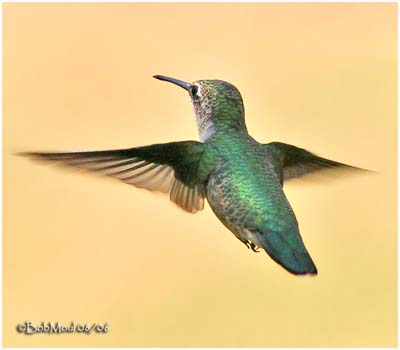
When migrating, Ruby-throated Hummingbirds fly non stop across the Gulf Coast, and they need about 20 hours to fly the 800 km across the Gulf. Endurance is the most important aspect of their flight.
REPRODUCTION:
After mating, female selects a nest site, usually near the tip of a down sloping branch, with openness below, and a leaf canopy above.
Ruby-throated Hummingbird’s nest is sometimes near or above water, and built by female alone. It is a tiny cup of wadded plant down, and bounded with spider web or pine resin. It is covered with lichens, making it very well hidden.
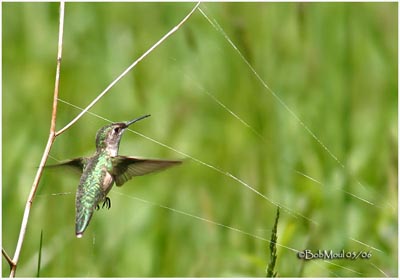
Female lays 1 to 3 eggs. Incubation lasts about 10 to 14 days by female. Chicks hatch altricial and are fed by female. They leave the nest at about 18 to 22 days of age. Female feeds them still 4 to 7 days after fledging.
Young probably reach their sexual maturity at one year.
This species produces up to three clutches per year.
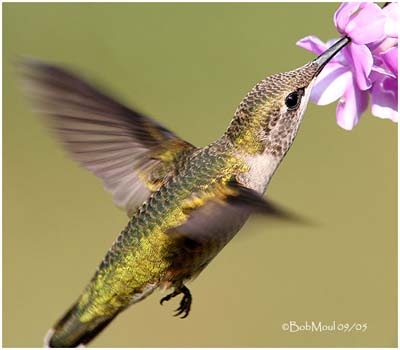
DIET:
Ruby-throated Hummingbirds feed mainly on floral nectar and insects, such as gnats, flies and small bees, and spiders. They may eat also tree sap if nectar becomes scarce.
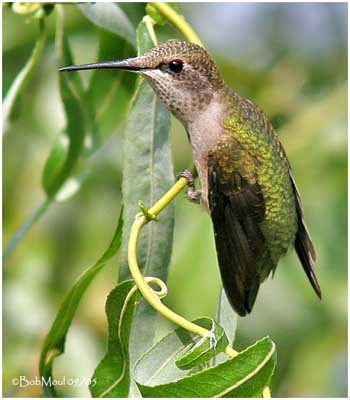
PROTECTION/THREATS/ STATUS:
Ruby-throated Hummingbirds have some predators. Blue Jays attack nestlings. Domestic cats, shrikes and hawks are predators for adults.
This species has an important role as pollinators. They compete with other species for food.